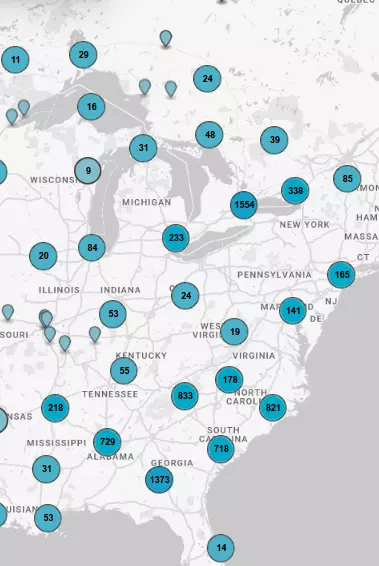CAMP CRILEY 1872
CAMP CRILEY 1872 Camp Criley was established in 1872 as a supply station for workmen building the Santa Fe Railroad, name changed to Garfield in 1873 by pioneers settling here. This park...
- kshs
- kansas
DISCOVERER OF PLUTO
DISCOVERER OF PLUTO Burdett is the boyhood home of Dr. Clyde Tombaugh, discoverer of the planet Pluto. Born in Illinois in 1906, he grew up on a farm northwest of here and was graduated...
- kshs
- kansas
- pluto
THE CALIFORNIA- OREGON TRAIL
THE CALIFORNIA-OREGON TRAIL From the 1830s to the 1870s, the 2,000-mile road connecting Missouri river towns with California and Oregon was America's greatest transcontinental highway. Several...
- kshs
- kansas
LOUIS VIEUX
LOUIS VIEUX Of Pottawatomie Indian and French ancestry, Louis Vieux was an early resident of this area. Probably born near Lake Michigan, Vieux, with a portion of the Pottawatomies, moved to Iowa...
- kshs
- kansas
ST MARYS
ST MARYS This city and college take their name from St. Mary's Catholic Mission founded here by the Jesuits in 1848 for the Pottawatomie Indians. These missionaries, who had lived with the...
- kshs
- kansas
THE VIEUX CROSSING
THE VIEUX CROSSING A few miles to the northwest, the Oregon-California trail crossed the Vermillion Creek heading toward the Pacific from the 'jumping off' towns on the Missouri River. The...
- kshs
- kansas
COUNTRY OF THE PAWNEES
COUNTRY OF THE PAWNEES For many centuries this region was the homeland of the Republic band (Kitkahahakis) of Pawnees. A numerous and prosperous people, the Pawnees dominated the north central...
- kshs
- kansas
PAWNEE INDIAN VILLAGE MUSEUM
PAWNEE INDIAN VILLAGE MUSEUM This is the site of a large, fortified village of the Republican band of Pawnee Indians, occupied during the early 1800s. As the inscription on the stone marker...
- kshs
- kansas
THE CHISHOLM TRAIL
THE CHISHOLM TRAIL At the close of the Civil War when millions of longhorns were left on the plains of Texas without a market, the Union Pacific was building west across Kansas. Joseph McCoy,...
- kshs
- kansas
INDIAN TREATIES OF 1865
INDIAN TREATIES OF 1865 Hundreds of Cheyennes, Arapahos, Kiowas, Apaches, and Comanches camped not far from here in 1865 to negotiate peace with the U.S. government. Both sides at the...
- kshs
- kansas
FARGO SPRINGS AND SPRINGFIELD
FARGO SPRINGS AND SPRINGFIELD The importance of railroads to the early settlement and prosperity of the West is nowhere better illustrated than in the stories of two Seward county towns....
- kshs
- kansas
WHEN CORONADO CAME TO KANSAS
WHEN CORONADO CAME TO KANSAS Francisco Vasquez de Coronado, with 36 soldiers and Father Juan de Padilla, marched north from the Rio Grande valley in the spring of 1541. Coronado's objective...
- kshs
- kansas
FOOL CHIEFS VILLAGE
FOOL CHIEFS VILLAGE The Kansa, for whom the state is named, once occupied 20 million acres of land in eastern and northern Kansas. In 1825 the U.S. government reduced the lands to a reservation...
- kshs
- kansas
THE GEOGRAPHIC CENTER
THE GEOGRAPHIC CENTER In a park three miles north and one mile west is the exact geographic center of the 48 contiguous states. The location has been officially established by the U.S....
- kshs
- kansas
CHISHOLM TRAIL IN SUMNER COUNTY
CHISHOLM TRAIL IN SUMNER COUNTY The Chisholm Trail probably began as a buffalo migration route, linking summer pastures in the Central Plains to winter pastures in Texas. American Indians followed...
- kshs
- kansas
HISTORICAL KANSAS
HISTORICAL KANSAS When Kansas territory was opened for white settlement on May 30, 1854, a bitter contest developed over the slavery question. Established the following December, Topeka, 25 miles...
- kshs
- kansas
FORT WALLACE
FORT WALLACE First called Camp Pond Creek, Fort Wallace was established in 1865. The fort served as the headquarters for troops given the task of protecting travelers headed west along the...
- kshs
- kansas
BUTTERFIELD STAGE LINE
BUTTERFIELD STAGE LINE When the Kansas Territory was created in 1854, it stretched all the way to the Rocky Mountains. The current state boundary, a few miles west of here, took effect in 1861...
- kshs
- kansas
HOLLENBERG RANCH AND THE PONY EXPRESS
HOLLENBERG RANCH AND THE PONY EXPRESS Begun in 1858, the Hollenberg Ranch, four miles north and one mile east of here, served as a stop on the Oregon-California Trail until the late 1860s. Gerat...
- kshs
- kansas
OPENING OF THE MID- CONTINENT OIL FIELD
OPENING OF THE MID-CONTINENT OIL FIELD Kansas has long been oil country. There are legends that Indians held council around the lights of burning springs. Emigrants, it is known, skimmed...
- kshs
- kansas
